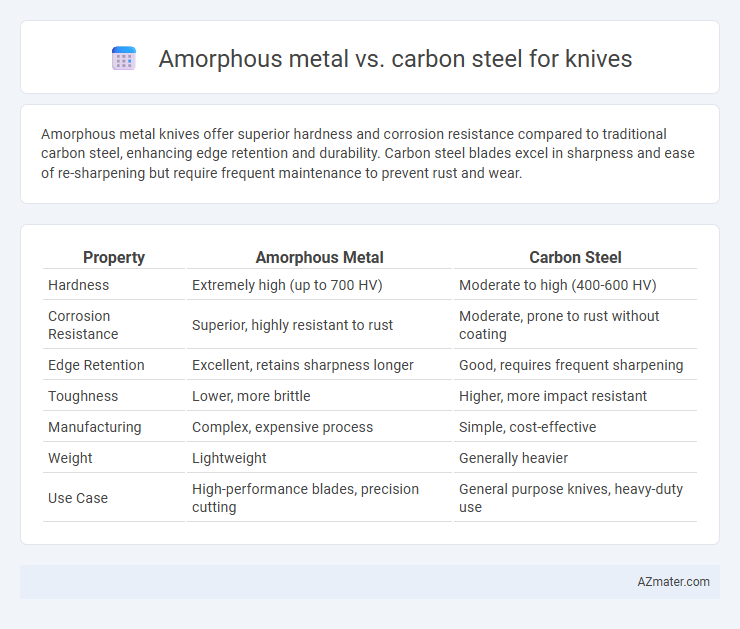Amorphous metal knives offer superior hardness and corrosion resistance compared to traditional carbon steel, enhancing edge retention and durability. Carbon steel blades excel in sharpness and ease of re-sharpening but require frequent maintenance to prevent rust and wear.
Table of Comparison
| Property | Amorphous Metal | Carbon Steel |
|---|---|---|
| Hardness | Extremely high (up to 700 HV) | Moderate to high (400-600 HV) |
| Corrosion Resistance | Superior, highly resistant to rust | Moderate, prone to rust without coating |
| Edge Retention | Excellent, retains sharpness longer | Good, requires frequent sharpening |
| Toughness | Lower, more brittle | Higher, more impact resistant |
| Manufacturing | Complex, expensive process | Simple, cost-effective |
| Weight | Lightweight | Generally heavier |
| Use Case | High-performance blades, precision cutting | General purpose knives, heavy-duty use |
Introduction to Amorphous Metal and Carbon Steel
Amorphous metal, also known as metallic glass, is characterized by a non-crystalline atomic structure that gives it exceptional hardness and corrosion resistance, making it an innovative material for knife blades. Carbon steel, a traditional alloy composed primarily of iron and carbon, is renowned for its sharp edge retention, ease of sharpening, and toughness. Comparing these materials highlights the advanced wear resistance of amorphous metal against the classic durability and workability of carbon steel in knife applications.
Composition and Structure Differences
Amorphous metals, also known as metallic glasses, have a disordered atomic structure without a crystalline lattice, contributing to superior hardness and corrosion resistance compared to carbon steel. Carbon steel consists of iron and carbon with a regular crystalline grain structure, which can be hardened through heat treatment but remains more prone to corrosion and wear. The unique composition of amorphous metals includes alloying elements arranged in a random atomic pattern, enhancing toughness and sharpness retention in knives compared to the grain boundaries and microstructural consistency found in carbon steels.
Hardness and Edge Retention
Amorphous metal knives exhibit significantly higher hardness, often exceeding 70 HRC, compared to carbon steel blades which typically range between 55-65 HRC, resulting in superior edge retention for amorphous metals. The non-crystalline atomic structure of amorphous metals reduces wear and deformation, maintaining a sharper edge over extended use. Carbon steel offers easier sharpening but loses sharpness faster due to its crystalline grain boundaries that promote chipping and abrasion.
Corrosion and Rust Resistance
Amorphous metal knives exhibit superior corrosion and rust resistance compared to carbon steel due to their non-crystalline atomic structure, which eliminates grain boundaries where corrosion typically initiates. Carbon steel blades, while strong and easy to sharpen, are more prone to rust and require regular maintenance to prevent oxidation. The enhanced chemical stability of amorphous metals makes them ideal for environments with high moisture or acidic exposure, offering longer-lasting blade integrity.
Toughness and Durability
Amorphous metal knives exhibit superior toughness due to their non-crystalline atomic structure, providing enhanced resistance to chipping and wear compared to carbon steel. Carbon steel offers excellent edge retention but is more prone to corrosion and requires regular maintenance to preserve durability. The combination of high toughness in amorphous metal and the easy sharpening properties of carbon steel defines their practical performance differences for knife applications.
Ease of Sharpening
Amorphous metal knives exhibit a highly uniform atomic structure resulting in enhanced wear resistance but can be more challenging to sharpen due to their hardness and lack of crystalline grain boundaries. Carbon steel, with its crystalline grain structure, is generally easier to sharpen and can achieve a razor-sharp edge more quickly with standard sharpening tools, though it requires more frequent maintenance. The choice between amorphous metal and carbon steel hinges on balancing ease of sharpening against edge retention and durability.
Manufacturing Processes
Amorphous metals, also known as metallic glasses, are produced through rapid solidification techniques such as melt spinning or twin-roll casting, which prevent crystallization and create a non-crystalline structure. In contrast, carbon steel knives undergo traditional smelting and forging processes, followed by heat treatments like annealing or quenching to achieve desired hardness and toughness. The manufacturing of amorphous metal knives allows for a more uniform microstructure and higher corrosion resistance, while carbon steel knives benefit from well-understood forging practices that optimize edge retention and ease of sharpening.
Cost and Availability
Amorphous metal knives typically have higher production costs due to complex manufacturing processes, resulting in limited availability and premium pricing compared to carbon steel knives. Carbon steel knives are widely accessible, benefiting from well-established supply chains and lower material costs, making them more budget-friendly for most consumers. The cost-effectiveness and broad availability of carbon steel make it a preferred choice for everyday kitchen and outdoor knives.
Applications in Knife Making
Amorphous metal exhibits superior hardness and corrosion resistance compared to traditional carbon steel, making it ideal for high-performance knives used in tactical and precision cutting applications. Its non-crystalline structure allows for exceptional edge retention and wear resistance, which benefits blades requiring long-lasting sharpness without frequent maintenance. Carbon steel remains favored in traditional knife making due to its ease of sharpening and toughness, particularly suited for outdoor and utility knives where flexibility and durability are prioritized.
Which Is the Better Choice for Your Knife?
Amorphous metal offers superior edge retention and corrosion resistance compared to carbon steel, making it ideal for knives requiring long-lasting sharpness and low maintenance. Carbon steel, known for its toughness and ease of sharpening, remains a preferred choice for users prioritizing durability and traditional blade feel. Selecting between amorphous metal and carbon steel depends on whether you value cutting performance with low upkeep or classic strength with straightforward maintenance.

Infographic: Amorphous metal vs Carbon steel for Knife
 azmater.com
azmater.com